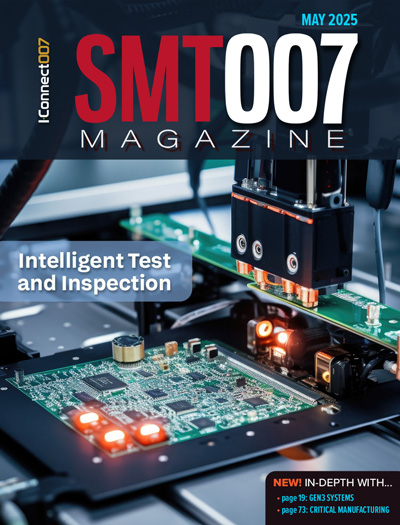-

- News
- Books
Featured Books
- smt007 Magazine
Latest Issues
Current Issue
What's Your Sweet Spot?
Are you in a niche that’s growing or shrinking? Is it time to reassess and refocus? We spotlight companies thriving by redefining or reinforcing their niche. What are their insights?

Moving Forward With Confidence
In this issue, we focus on sales and quoting, workforce training, new IPC leadership in the U.S. and Canada, the effects of tariffs, CFX standards, and much more—all designed to provide perspective as you move through the cloud bank of today's shifting economic market.

Intelligent Test and Inspection
Are you ready to explore the cutting-edge advancements shaping the electronics manufacturing industry? The May 2025 issue of SMT007 Magazine is packed with insights, innovations, and expert perspectives that you won’t want to miss.
- Articles
- Columns
- Links
- Media kit
||| MENU - smt007 Magazine
ODMs Slow Stocking; 4Q24 MLCC Shipments Expected to Decline by 3.6%
October 8, 2024 | TrendForceEstimated reading time: 2 minutes
TrendForce’s latest findings show that recent economic data points to a steady cooling of inflation in the US market, prompting the Federal Reserve to cut interest rates by 50 basis points in September to prevent a potential economic slowdown or recession. Additionally, the complex geopolitical landscape and uncertainties surrounding the US presidential election could dampen consumer spending, posing a significant risk to year-end holiday demand. Consequently, TrendForce forecasts that total shipments of MLCCs will reach approximately 1.205 trillion units in 4Q24—representing a quarterly decline of 3.6%.
Smartphones and notebooks see conservative demand, but AI server growth remains robust, benefiting Japanese and Korean suppliers
TrendForce notes that order forecasts for Q4 notebooks from ODMs have decreased by an average of 5% to 8%. ODMs have taken a cautious approach to component stocking since mid-September due to conservative planning by OEMs for orders related to smartphones, notebooks, networking equipment, and tablets. Their stocking attitudes remain reserved even in light of the Chinese National Day holiday and the upcoming holiday shopping season in Europe and the US.
While there has been a slight increase in demand for business notebooks and Huawei’s new foldable smartphone, Apple’s recently launched AI-enabled iPhone 16 has yet to generate a significant replacement cycle. The newly introduced Apple Intelligence still requires time to mature in its applications.
In contrast, demand for AI servers continues to gain momentum. Although NVIDIA’s Blackwell GPUs have faced production delays until mid-Q4 due to adjustments to mask-design, orders for Hopper-based H100/H200 GPUs have increased by 65%, and demand for the scaled-down H20 GPU variant has risen by 33%. This trend has simultaneously driven increased demand for US-based CSPs for 400G Switches and from AWS for AI accelerator cards using Annapurna network chips.
Consequently, some network manufacturers have seen their order forecast for Q4 grow by nearly 15%. TrendForce reports that the demand for high-end MLCCs in Q4 remains stable, allowing Japanese and Korean suppliers to better plan their capacity allocations in preparation for a surge in GB200 orders next year.
Weaker dollar and strengthening Asian currencies increase MLCC suppliers’ operational and pricing pressures
The US dollar has weakened due to the Federal Reserve initiating a rate-cut cycle, leading to a rise in Asian currencies. The Japanese yen, in particular, broke the 140 yen-to-1 dollar mark in mid-September. TrendForce reveals that MLCC suppliers not only facing weaker demand in Q4 but also increased risks of foreign exchange losses, further adding to their operational pressures. In response, suppliers are planning to control capacity utilization rates and lower inventory levels to stabilize product pricing and maintain revenue and profitability.
TrendForce’s investigations show that the average capacity utilization rates for Japanese and Korean suppliers remain above 80%, while Taiwanese and Chinese manufacturers are operating at a more modest 60% to 70%. Suppliers have adopted a more cautious approach to operations and pricing strategies with the peak season in the second half of the year falling short of expectations and fourth quarter demand slowing down.
Testimonial
"Our marketing partnership with I-Connect007 is already delivering. Just a day after our press release went live, we received a direct inquiry about our updated products!"
Rachael Temple - AlltematedSuggested Items
Alphabet Boosted by AI, Cloud Demand as Spending Needs Jump
07/24/2025 | I-Connect007 Editorial TeamGoogle’s parent company, Alphabet Inc., said that demand for artificial intelligence products boosted its quarterly sales, and now requires an extreme increase in capital spending to keep up in the AI race, Bloomberg reported. For 2025, the company stated its capital expenditure will be $85 billion—$10 billion more than previously forecast.
Southwest Antennas Secures First Major European Order for their Permanent Mounting Kits
07/24/2025 | Southwest AntennasSouthwest Antennas is proud to announce the receipt of its first major European order for the company’s Permanent Mounting Kits, marking a significant milestone in its international expansion efforts.
Global Dry Film Photoresist Market Set for Robust Growth with Expanding Semiconductor Ecosystem
06/24/2025 | PRNewswireIn 2024, the global market size of Dry Film Photoresist was estimated to be worth US$939 million and is forecast to reach approximately US$1191 million by 2031 with a CAGR of 3.5% during the forecast period 2025-2031.
Roll-to-Roll Technologies for Flexible Devices Set to Grow at 11.5% CAGR
06/11/2025 | GlobeNewswireAccording to the latest study from BCC Research, the “Global Markets for Roll-to-Roll Technologies for Flexible Devices” is expected to reach $69.8 billion by the end of 2029 at a compound annual growth rate (CAGR) of 11.5% from 2024 to 2029.
Tariff Effects and China Subsidies Soften 1Q25 Downturn; Foundry Revenue Decline Narrows to 5.4%
06/09/2025 | TrendForceTrendForce’s latest investigations find that the global foundry industry recorded 1Q25 revenue of US$36.4 billion—a 5.4% QoQ decline. The downturn was softened by last-minute rush orders from clients ahead of the U.S. reciprocal tariff exemption deadline, as well as continued momentum from China’s 2024 consumer subsidy program.


